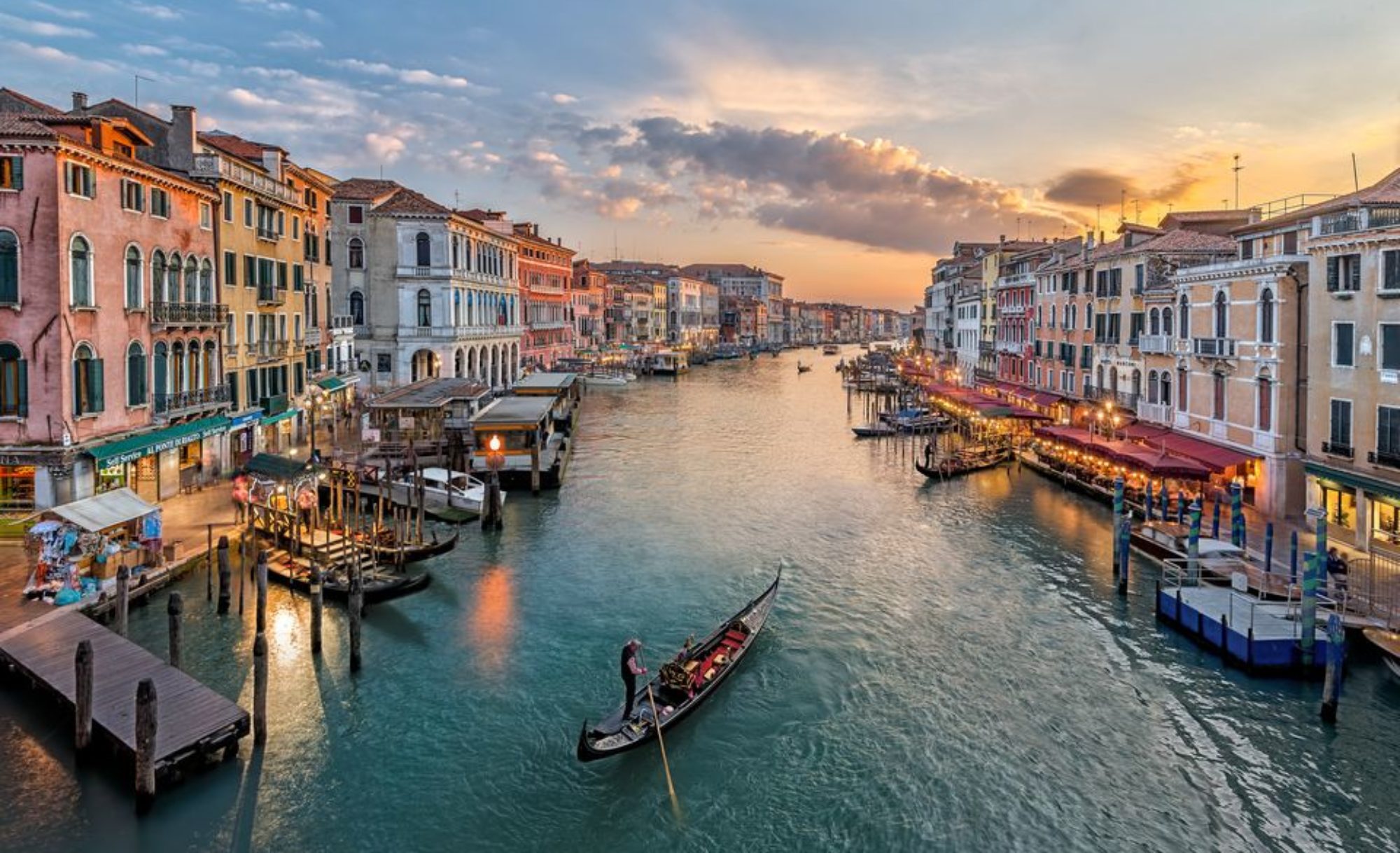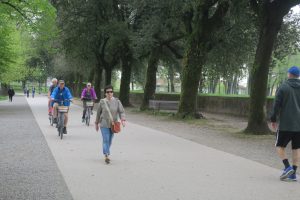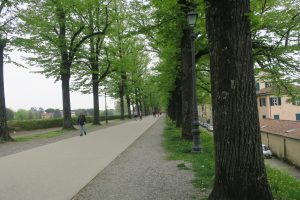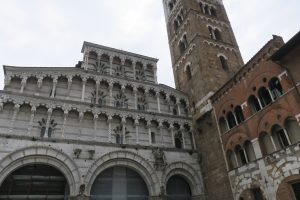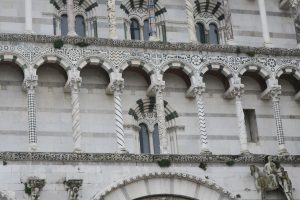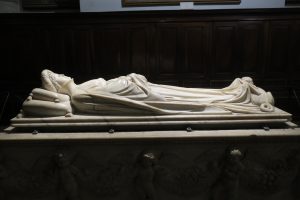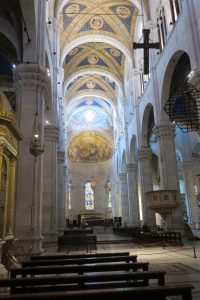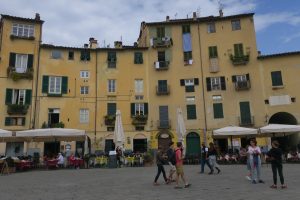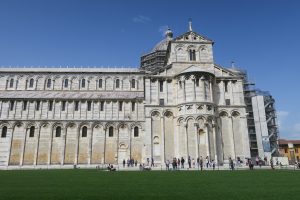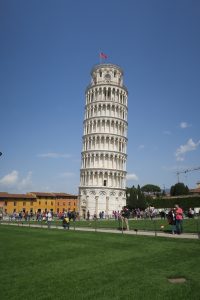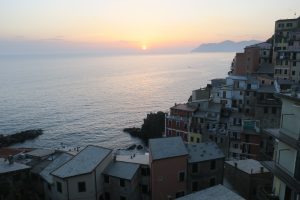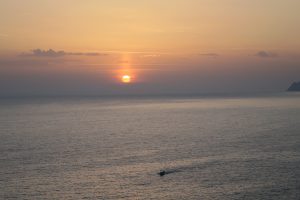We were up and out early because we plan to go to Lucca and Pisa today. It was about an hour and a half drive to Lucca. We got lost in the Lucca town center so we just parked the car and decided to walk.
Rick Steves describes Lucca as “Italy’s most impressive fortress city, encircled by a perfectly intact wall.” Our main goal in going to Lucca was to ride bikes atop the wall. We quickly found a bike shop but decided we needed a little fortification ourselves before biking. After a “coffee” we started our bike tour on the wall. On top of the wall is a nice park with paved and grassy areas; it is quite wide up there.
It was a really nice ride. There were lots of people out and it definite seemed like an area where the citizens of Lucca gather and commune.
After returning our bikes we went to a church, San Martino Cathedral, that we had seen from the ramparts. It had a very ornate facade, a mix of architectural and artistic styles according to Rick Steves. Inside it looked much bigger than it looked outside. The Volto Santo, a wooden crucifix, is housed in a small, elaborate, birdcage-like temple in the church. It is said to have been sculpted by Nicodemus in Jerusalem and set afloat in an unmanned boat that landed on the coast of Tuscany, from where wild oxen miraculously carried it to Lucca in 782. It also contains the tomb of Ilaria del Carretto. This young bride of silk baron Paolo Guinigi is so realistically realized that the statue was nicknamed “Sleeping Beauty.” Her nose is partially worn off because of a long-standing tradition of lonely young ladies rubbing it for luck in finding a boyfriend. Here are some pictures of the church, the Volto Santo, and the tomb.
Then we went to Piazza dell’Anfiteatro to find a place for lunch. The piazza was originally a 10,000 seat Roman theater which sat just outside rectangular city wall. With the fall of Rome, the theater was gradually cannibalized for its stones and inhabited by people living in a mishmash of huts. The huts were cleared away at the end of the 19th century to better show off the town’s illustrious past and make one purely secular square (every other square is dominated by a church) for the town market. The square is really an oval. We had a great lunch. Here are pictures of the square, I mean oval.
Then we headed for Pisa. We parked and immediately walked to the tower. It was much more beautiful than we though it would be. Here’s the history from Rick Steves’ book – “The Tower was built over two centuries by at least three different architects. You can see how each successive architect tried to correct the leaning problem—once halfway up (after the fourth story), once at the belfry on the top. The first stones were laid in 1173, probably under the direction of the architect Bonanno Pisano. Five years later, just as the base and the first arcade were finished, someone said, “Is it just me, or does that look crooked?” The heavy Tower—resting on a very shallow 13-foot foundation—was sinking on the south side into the marshy, multilayered, unstable soil. The builders carried on anyway, until they’d finished four stories. Then, construction suddenly halted—no one knows why—and for a century the Tower sat half-finished and visibly leaning. Around 1272, the next architect continued, trying to correct the problem by angling the next three stories backward, in the opposite direction of the lean. The project then again sat mysteriously idle for nearly another century. Finally, Tommaso Pisano put the belfry on the top (c. 1350-1372), also kinking it to overcome the leaning. After the Tower’s completion, several attempts were made to stop its slow-motion fall. The architect/ artist/ writer Giorgio Vasari reinforced the base in 1550, and it actually worked. But in 1838, well-intentioned engineers pumped out groundwater, destabilizing the Tower and causing it to increase its lean at a rate of a millimeter per year. It got so bad that in 1990 the Tower was closed for repairs, and $30 million was spent trying to stabilize it. Engineers dried the soil with pipes containing liquid nitrogen, anchored the Tower to the ground with steel cables, and buried 600 tons of lead on the north side as a counterweight (not visible)—all with little success. The breakthrough came when they drilled 15-foot-long holes in the ground on the north side and sucked out 60 tons of soil, allowing the Tower to sink on the north side and straighten out its lean by about six inches.”
We tried to go into the Duomo but we couldn’t get tickets. Here are pictures of the tower and church.
We returned to Riomaggiore and had dinner in the apartment. Here’s a picture from our apartment of the sunset that evening.
